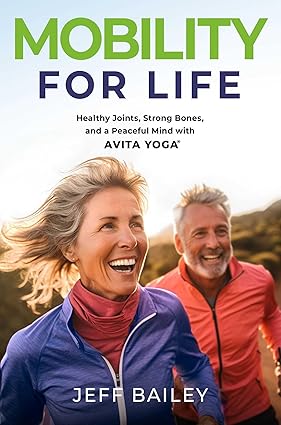The Revolutionary Avita Yoga Guide That Transforms Joint Health, Eliminates Arthritis Pain, and Restores Youthful Movement Through Gentle, Science-Based Practice

When chronic joint pain, arthritis, and mobility limitations threaten to steal your independence and quality of life, “Mobility for Life: Healthy Joints, Strong Bones, and a Peaceful Mind with Avita Yoga” by Jeff Bailey emerges as a transformative guide that challenges conventional approaches to aging and movement. This isn’t just another yoga book collecting dust on wellness shelves; it’s a scientifically-grounded roadmap that empowers you to reclaim your body’s natural ability to heal, strengthen, and move with grace throughout your lifetime.
Published by WowXV Team | Books
Jeff Bailey, founder of Avita Yoga and renowned movement specialist, presents a revolutionary approach that fundamentally shifts how we understand joint health, bone strength, and the aging process. Through decades of research and practical application, Bailey has developed a system that proves mobility isn’t something we inevitably lose with age—it’s something we can actively cultivate and maintain through intelligent, purposeful movement practices.
The core philosophy of “Mobility for Life” centers on the principle of “doing less and moving smarter,” a concept that challenges the traditional fitness industry’s emphasis on high-intensity, high-impact exercise. Bailey demonstrates how gentle, intentional movements can produce more profound and lasting results than aggressive workout routines that often lead to injury and burnout, particularly for individuals over 40.
The Avita Yoga system presented in this book represents a departure from traditional yoga practices that emphasize flexibility and extreme poses. Instead, Bailey focuses on mobility—the functional ability to move joints through their natural range of motion with control and stability. This distinction proves crucial for individuals dealing with arthritis, joint stiffness, or age-related movement limitations.
The book’s scientific foundation rests on cutting-edge research in bone remodeling, joint mechanics, and neuroplasticity. Bailey explains how bones constantly rebuild themselves throughout our lives, responding to the specific stresses and movements we provide. By understanding these biological processes, readers learn to work with their body’s natural healing mechanisms rather than against them.
One of the book’s most compelling aspects is its accessibility to individuals regardless of their current fitness level or mobility limitations. Bailey provides modifications and progressions that accommodate everyone from complete beginners to those dealing with significant physical challenges. The gentle nature of Avita Yoga makes it particularly valuable for individuals who have been told they’re “too old” or “too injured” for traditional exercise programs.
The four-zone approach outlined in the book addresses the body’s primary movement patterns and joint systems. Bailey systematically guides readers through targeted practices for the spine, hips, shoulders, and core, demonstrating how these areas work together to create fluid, pain-free movement. Each zone receives detailed attention with specific exercises, breathing techniques, and mindfulness practices.
📚 TRANSFORMATIVE WELLNESS: Mobility for Life Healthy Joints Strong Bones Peaceful Mind Avita Yoga Jeff Bailey (As an Amazon Associate I earn from qualifying purchases.)
The book’s approach to arthritis management represents a paradigm shift from traditional medical models that often focus on symptom management rather than root cause resolution. Bailey presents evidence-based strategies for reducing inflammation, improving joint lubrication, and strengthening the supportive structures around affected joints. Readers learn how specific movements can actually help rebuild cartilage and improve joint function over time.
The mental and emotional components of the Avita Yoga system receive equal attention to the physical practices. Bailey explores the connection between chronic pain, stress, and movement patterns, demonstrating how mindfulness and breath work can break the cycle of pain and limitation that traps many individuals in declining health trajectories.
The book’s practical structure makes it easy for readers to implement the teachings immediately. Each chapter builds upon previous concepts while providing standalone practices that can be integrated into daily routines. Bailey includes detailed instructions, safety considerations, and troubleshooting guidance to ensure readers can practice safely and effectively.
The bone health section of the book challenges common misconceptions about osteoporosis and bone density. Bailey explains how weight-bearing movement, when applied intelligently, can stimulate bone growth and strength even in individuals with existing bone density concerns. The gentle loading principles of Avita Yoga provide the necessary stimulus for bone remodeling without the high-impact stress that can lead to fractures.
The book addresses the psychological barriers that often prevent individuals from maintaining consistent movement practices. Bailey explores the fear-based thinking that develops around pain and aging, providing tools for shifting mindset and building confidence in the body’s ability to heal and improve. This psychological component proves essential for long-term success and adherence to the practices.
The scientific explanations throughout the book remain accessible to general readers while providing sufficient depth for those interested in understanding the mechanisms behind the practices. Bailey skillfully bridges the gap between complex physiological concepts and practical application, making the science relevant and actionable for everyday life.
The book’s emphasis on sustainability sets it apart from quick-fix approaches that dominate the wellness industry. Bailey presents a long-term vision for health and mobility that acknowledges the natural changes that occur with aging while demonstrating how to age with strength, grace, and vitality. The practices are designed to evolve with the practitioner, providing lifelong tools for maintaining and improving function.
The community aspect of Avita Yoga receives attention in the book, with Bailey discussing the importance of social connection and support in maintaining healthy aging. He provides guidance for finding or creating supportive communities around movement and wellness, recognizing that isolation often compounds the challenges of aging and chronic pain.
The book’s approach to balance and fall prevention addresses one of the most significant health concerns for aging adults. Bailey presents specific practices for improving proprioception, strengthening stabilizing muscles, and developing the confidence and reflexes needed to prevent falls and maintain independence.
The integration of Eastern and Western approaches to health and healing creates a comprehensive framework that honors both ancient wisdom and modern scientific understanding. Bailey demonstrates how traditional yoga principles can be enhanced and validated through contemporary research, creating a practice that is both time-tested and evidence-based.
The book’s treatment of chronic pain conditions extends beyond arthritis to include discussions of fibromyalgia, chronic fatigue, and other conditions that affect mobility and quality of life. Bailey provides hope and practical strategies for individuals who have been told their conditions are permanent or progressive, demonstrating how gentle movement can often improve symptoms and function.
The nutritional and lifestyle components of joint health receive appropriate attention without overwhelming the movement-focused content. Bailey provides practical guidance for supporting the physical practices through proper nutrition, hydration, and sleep, creating a holistic approach to wellness that addresses all aspects of health.
The book’s discussion of pain science helps readers understand the difference between harmful pain that signals injury and the discomfort that often accompanies positive change and healing. This education proves crucial for individuals who have developed fear-based relationships with their bodies and movement.
The progressive nature of the Avita Yoga system allows practitioners to start where they are and gradually build strength, mobility, and confidence over time. Bailey provides clear guidelines for progression and modification, ensuring that the practices remain challenging yet achievable throughout the practitioner’s journey.
The book addresses the unique challenges faced by individuals with sedentary lifestyles, providing specific strategies for counteracting the effects of prolonged sitting and limited movement. These practices prove particularly valuable for office workers and others whose occupations require extended periods of inactivity.
The emphasis on functional movement patterns ensures that the benefits of practice translate directly into improved daily activities. Rather than focusing on abstract poses or exercises, Bailey demonstrates how the movements relate to real-world activities like walking, climbing stairs, and performing household tasks.
The book’s exploration of the mind-body connection provides readers with tools for developing greater body awareness and intuition. Bailey teaches readers to listen to their bodies’ signals and respond appropriately, developing the internal guidance system necessary for safe and effective self-care.
The seasonal and cyclical approaches to practice acknowledge the natural rhythms of the body and the importance of adapting practices to changing needs and circumstances. Bailey provides guidance for modifying practices based on energy levels, health status, and life circumstances, creating a sustainable approach to long-term wellness.
The book’s treatment of injury recovery and prevention provides valuable guidance for individuals dealing with acute or chronic injuries. Bailey demonstrates how gentle movement can support the healing process while preventing the deconditioning that often accompanies injury recovery.
The integration of breathing practices throughout the movement sequences enhances the therapeutic benefits while promoting relaxation and stress reduction. Bailey explains the physiological mechanisms behind breath work and provides specific techniques for different situations and needs.
The book’s discussion of sleep and recovery emphasizes the importance of rest and restoration in the healing process. Bailey provides practices specifically designed to promote better sleep quality and support the body’s natural recovery mechanisms.
The accessibility modifications presented throughout the book ensure that individuals with physical limitations can participate fully in the practices. Bailey provides chair-based alternatives, wall-supported variations, and other adaptations that make the system truly inclusive.
The book’s approach to goal setting and progress tracking helps readers maintain motivation and recognize improvements that might otherwise go unnoticed. Bailey provides tools for measuring progress beyond traditional metrics, focusing on functional improvements and quality of life enhancements.
The long-term vision presented in the book inspires readers to view their health journey as an ongoing adventure rather than a problem to be solved. Bailey demonstrates how the practices can evolve and deepen over time, providing lifelong tools for growth and discovery.
Amazon Associates Disclaimer: This post contains affiliate links. As an Amazon Associate, I earn from qualifying purchases. This means that if you click on one of the product links and make a purchase, I may receive a small commission at no additional cost to you. This helps support the blog and allows me to continue providing valuable content. I only recommend products that I believe will add value to my readers. Thank you for your support!
Pros
- Revolutionary approach that challenges conventional fitness and aging paradigms
- Science-based methodology supported by research in bone remodeling and joint mechanics
- Accessible to all fitness levels and physical limitations with comprehensive modifications
- Gentle, sustainable practices that work with the body's natural healing mechanisms
- Comprehensive coverage of joint health, bone strength, and mental well-being
- Practical structure with immediate implementation strategies and daily routines
- Expert author with decades of experience and proven track record
- Addresses psychological barriers and fear-based thinking around pain and aging
- Holistic approach integrating movement, breath work, and mindfulness practices
- Specific strategies for arthritis management and chronic pain conditions
- Evidence-based bone health protocols that stimulate natural bone remodeling
- Progressive system that evolves with the practitioner's changing needs
- Functional movement patterns that translate directly to daily activities
- Community-building guidance for sustainable long-term practice
- Comprehensive safety considerations and troubleshooting guidance
Cons
- Requires consistent practice and patience for optimal results
- May challenge deeply held beliefs about aging and physical limitations
- Gentle approach may not appeal to those preferring high-intensity exercise
- Initial learning curve for understanding movement principles and techniques
The Avita Yoga Guide That Revolutionizes Joint Health and Transforms Aging
"Mobility for Life" by Jeff Bailey presents a groundbreaking approach to joint health and aging through Avita Yoga, demonstrating how gentle, science-based movements can resolve arthritis pain, strengthen bones, and restore youthful mobility. This comprehensive guide challenges conventional fitness paradigms while providing accessible, sustainable practices that work with the body's natural healing mechanisms to promote lifelong wellness and vitality.








